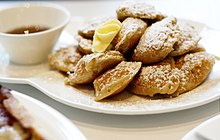Poffertjes
Poffertjes are a Dutch specialty pastry that resembles small, coin-sized pancakes . They are relatively thick, are served with small pieces of butter and sprinkled with a lot of powdered sugar, which makes them much sweeter than normal pancakes. In the Netherlands, poffertjes are often garnished with stroop (sugar beet syrup).
history
Originally, the Poffertjes from France, where a legend, according to 1795 near come Bordeaux monks for their hosts on buckwheat flour umstiegen and so manufactured the first Poffertjes. Business people were very impressed by the new baking pan and carried the news of the fine pancakes during the French Revolution to the Netherlands, where the recipe was still being changed. The Dutch poffertjes, then still called Broedertjes , were initially mainly sold at fairs and church fairs and quickly became popular.
Today, poffertjes have the status of a national dish in the Netherlands and are a popular, everyday pastry specialty that is offered and consumed at many poffertjes stalls on the street across the country, in addition to many bakeries, pastry shops, cafés and restaurants. Meanwhile Poffertjesstände are occasionally in Germany to be found, especially in northern Germany and in the Rhineland and in particular festivals, fairs and Christmas markets.
Ingredients, accessories and preparation
Authentic Nederlandse Poffertjes contain wheat flour and buckwheat flour in a mixing ratio of 1: 1; other ingredients are milk , eggs , yeast , a little salt , melted butter and sugar or syrup. The dough is mixed to be relatively thin.
Poffertjes are baked in a special pan - the poffertjespan - whose bases have rounded depressions ("hollows", "dimples") that are no more than 4 cm in diameter and into which a good tablespoon of the dough fits. Mostly these hollow or dimple pans are made of cast iron ; however, aluminum and copper pans are also available. Common pans on the stove in the home have around 15 to 20 recesses. There are also small electrically operated Poffertjes appliances and Poffertjes Makers for household use. In factories and in Poffertjesständen professional catering equipment is used mostly to retailers as a Poffertjesgerät or Poffertjes grill are called. Today they are mostly made of cast iron, have around 50 to 100 hollows and are usually electrically heated.
Before each baking process, the wells are greased, usually by brushing them with liquid edible fat . In the past, this was done with the help of a heat-resistant cotton cloth that was wrapped around one end of a handy, round wooden stick and tied tightly. The end of the stick prepared in this way was dipped in liquid fat, traditionally melted butter, and then the hollows were "wiped out" with it. This tradition can still be found at some poffertjes stalls. When baking, the dough is usually poured into the greased wells in the household with a tablespoon or a special plastic dosing bottle. In the professional production of poffertjes, the dough is usually poured into the recesses with a special dosing funnel (with a portioning bar). Traditionally, it was filled quickly with a long-handled ladle, which required a lot of practice.
Halfway through the baking time, the individual poffertjes are each turned with a mostly long-handled, two-pronged metal or wooden fork and baked to the end. However, the poffertjes are not fully baked through, so they still have a soft core. In addition to the usual ingredients (pieces of butter, powdered sugar, traditionally also beet syrup), they are offered or served with whipped cream and / or chopped fruit. Maple syrup is also used as an alternative to the hearty tasting sugar beet syrup.
See also
- Förtchen (or Pförtchen ; in Low German Futtjes ) and Æbleskiver ("apple slices") are the respective equivalents in Schleswig-Holstein and Denmark .
- The Bohemian Dalken are made with a higher proportion of egg and flour.
literature
- Ken Albala: Pancake. A global history. Reaction Books, London 2008, ISBN 978-1-86189-392-5 (English).
- Erik Winkelmann u. a .: Cooking in Dutch. Courts and their history. Verlag Die Werkstatt, Göttingen 2011, ISBN 978-3-89533-791-8 , pp. 43, 198.




